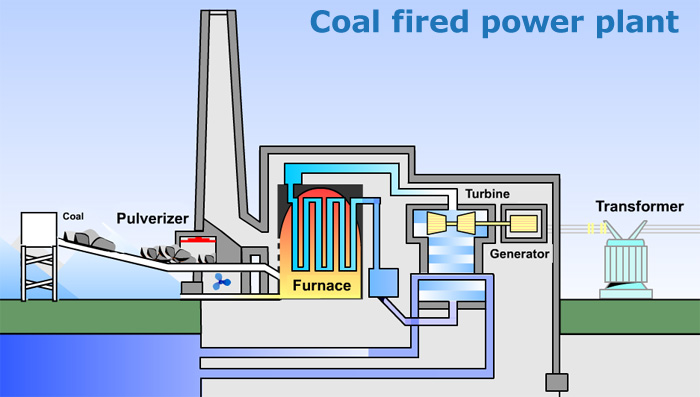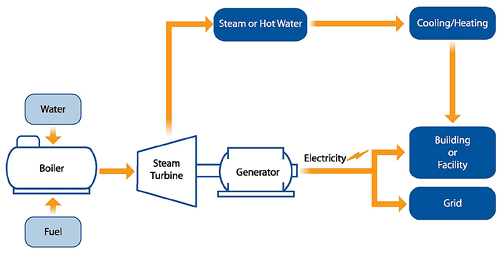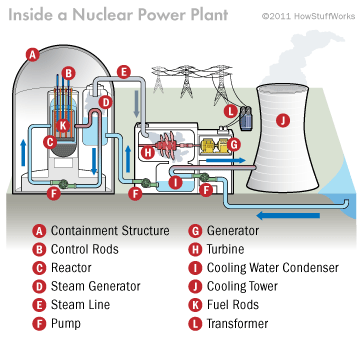Coal Fired Generation:
Though the 1970’s through the 1990’s, the popular electricity generators were coal or nuclear powered pla

nts. Coal power is an electricity source that provides inexpensive and reliable power. Coal power became more important when oil and natural gas supplies diminished. Coal is used as a substitute energy source for oil and natural gas. In 1995, coal burning produced about 55% of the electricity generated in
the U.S. Coal reserves are expected to last for centuries at current rates of usage. In the coal burning for power process, the coal is crushed into fine powder and fed into a combustion unit where it is burned. Heat from burning the coal is used to generate steam that is used to spin one or more turbines to generate electricity.
Natural Gas Electricity:
Due to economic, environmental and technological changes, Natural Gas electricity has been a very popular fuel generator in the 1990’s because of its clean, burning nature. The Energy Information Administration (EIA) estimates that between 2009-2015, 96.65 gigawatts of new electricity capacity will be added in the U.S. Of this, over 20% will be natural gas emissions. Coal is the cheapest fossil fuel for ge

nerating electricity, but it is also the dirtiest. Natural gas is a very clean alternative to prevent pollution. The main produ
cts of the combustion of natural gas are carbon dioxide and water vapor, the same compounds we exhale when we breathe. Coal and oil are composed of much higher levels of ha
rmful emissions such as carbon, nitrogen oxides, and sulfur dioxide. Natural gas can be used to generate electricity in a variety of ways. The most basic natural gas- fired electric power generator is the steam generation unit, where fossil fuels are burned into a boiler to heat water and produce steam an
d it turns a turbine to generate electricity. Natural gas may be used for this process.
Gas Turbines and Combustion Engines are also used to generate electricity. In this process, rather than heating steam to turn a turbine, hot gases from burning fossil fuels( natural gas) are used to turn the turbine and generate electricity.
Nuclear Power Plants:

Nuclear Power plants use heat generated from nuclear fission to convert water to steam, which powers turbines to produce electricity. Nuclear power plants operate in most states in the U.S and produce about 20% of the nations power. When an atom of nuclear fuel (ura
nium) absorbs a neutron, the uranium will fission into two smaller atoms and release one to three neutrons. The kinetic energy of the waste is used to convert water to steam which produces electricity. The cons about this process, are that it is very dangerous. If none of the neutrons are absorbed by another uranium atom, then the reactor dies out. If this happens too much, then the reaction grows extremely quickly and could explode. An accident like this could result in dangerous levels of radiation that could affect the health and safety of thousands of citizens living within a 10 mile radius of the power plant. Fortunately,
local and state government agencies and the electric utilities have emergency response plans and procedures in the event of a nuclear power plant incident. The plans cover two “zones”. One zone covers an area within a ten mile radius of the plant, where people could be harmed by radiation exposure. The second zone covers up to a fifty mile radius from the plant, where radioactive materials could affect water supplies, food crops, and livestock.
The release of radioactive material is so dangerous because the exposure can release radioactive gases and particles into the air. The major hazards to people exposed are radiation exposure to the body from the cloud and particles deposited on the ground, inhalation of radioactive materials and ingestion of radioactive materials. A high exposure to radiation can cause serious illness or death.
Sources:
http://www.rst2.edu/ties/acidrain/iecoal/how.htm
http://naturalgas.org/overview/uses-electrical/
http://www.ready.gov/nuclear-power-plants
http://nuclearinfo.net/Nuclearpower/HowPowerPlantsWork